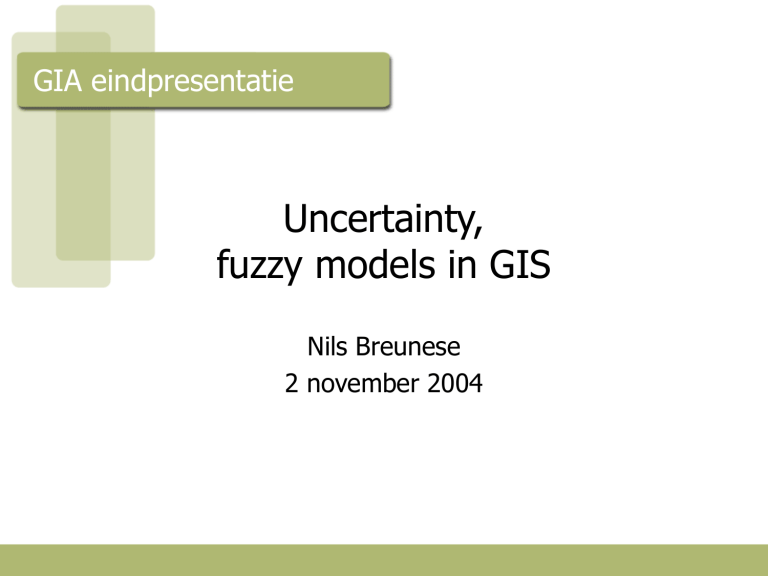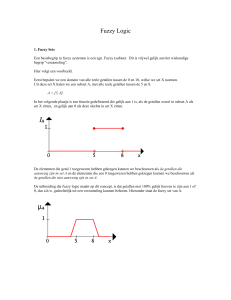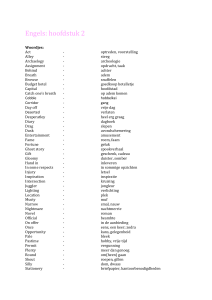
GIA eindpresentatie
Uncertainty,
fuzzy models in GIS
Nils Breunese
2 november 2004
Inhoud
• Spatial vagueness
• Uncertainty
• Fuzzy models
– Metric operations
• Future work
Introductie
• Spatial vagueness
– Uncertainty
• Gebrek aan informatie over positie en vorm
van een object met een bestaande grens
(positional uncertainty)
• Niet mogelijk object precies te meten
(measurement uncertainty)
– Fuzziness
• Object heeft inherent geen definieerbare
grens (bijv. wat is de grens tussen berg en
vallei?)
Uncertainty
• Uncertainty != error
• Error: eigenlijke waarde in principe
verkrijgbaar
– Inaccuracy, imprecision
• Ruimer begrip: eigenlijke waarde niet
per se verkrijgbaar (measurement
uncertainty)
• Kan ook gebrek aan informatie zijn
• Begrippen vaak door elkaar gebruikt:
Uncertainty, imprecision, inaccuracy,
ambiguity, inexactness, vagueness,
fuzziness
Uncertainty
•
•
•
•
Identificatie
Beschrijven en modelleren
Visualisatie
Effecten op output voorspellen
m.b.v. kennis over input
uncertainty
Identificatie
• Waar(door) treedt uncertainty op?
– Geografische abstractie en
generalisatie
– Data acquisitie
– Geo-processing
– Visualisatie
– Interpretatie
Geografisch perspectief
• Field-based
– Physical geography, environmental
applications
• Object-based
– Cartography, facilities management
• Keuze hangt af van o.a. data
acquisitie methode en database
implementatie
• Uncertainty modellering makkelijker
bij field-based, zeker bij combineren
lagen met verschillende uncertainty
Fields
Field models
Graphical
representation
Valid types of
variables
Examples
Irregular points
Continuous,
categorical
Weather station
data
Regular points
Continuous,
categorical
Laser profiling
data
Contours
Continuous
Noise level data
Polygons
Continuous,
categorical
Land cover data
Grids
Continuous,
categorical
Remotely sensed
data
Triangulated
Irregular
Networks (TINs)
Continuous
Topographic data
Objects
Point
(0-dimensional)
Entity point
Label point
Area point
Point
Node
Line segment
String
Arc
Link
Line
(1-dimensional)
Directed link
Simple chain
Area chain
Network chain
Chain
NCDCDS (1988):
National Committee
for
Digital Cartographic
Data Standards
Strings
Arcs
Links
Chains
Ring
(created from)
Interior area
Polygon
(simple or complex, i.e. with inner rings)
Area
(2-dimensional)
Pixel
Grid cell
ID1
L area
R area
ID2
Data acquisitie
• Ground-based surveying
– Landmetingen met ground control points
(GCPs)
– Global Positioning Systems (GPS)
• Photogrammetry
– Stereo plotter, Digital Elevation Models (DEMs)
• Remote sensing
– Vliegtuig: Airborne Thematic Mapper
– Satelliet: Landsat Multispectral Scanner,
Landsat Thematic Mapper, SPOT HRV
Beschrijven en modelleren
• Fuzzy set theorie
– Bekijk uncertainty als resultaat
van vaagheid i.p.v. willekeurigheid
(i.t.t. kansrekening)
• Accuracy vs precision
– Hoge precisie garandeert niet dat
een meting accuraat is
Fouten in objecten
• NCDCDS, 1988
• Interessantst voor analyse
– Attribute accuracy
– Positional accuracy
• Verder nog (Guptil & Morrison, 1995)
– Logical consistency
NCDCDS:
National Committee
for
Digital Cartographic
Data Standards
• Topologische tests
– Completeness
• Mate waarin data alle relevante en actuele
informatie bevat
– Lineage
• Beschrijving van gebruikt bronmateriaal,
methoden, controlepunten en rekenstappen
Fouten in objecten
1 n
m i
n i 1
1 n 2
RMSE
i
n i 1
• Attributen: kwalitatieve en
kwantitatieve feiten over
objecten, te scheiden van
geometrische gegevens
• Aandacht gaat uit naar
positionele accuraatheid
1 n
2
std
(
m
)
i
n i 1
Error ellipses
• Positional inaccuracy van punt
kan worden gerepresenteerd
met ellipsen met dat punt als
centrum
• Probability Density Function
X ( x) 2 X ( x) Y ( x) Y ( x) 2
pdf ( ( x))
exp
2
2
2
2
2
2
2( X Y XY
2 ( X Y XY )
1
X X0
met ( x) X x x0
Y
Y Y0
p ( ( x) err )
pdf ( ( x))d ( x)
( x ) err
Epsilon error bands
• Voorgesteld door Perkal (1956)
• Een ‘gang’ met breedte 2
• Point-in-polygon operatie: zeker
binnen, zeker buiten of onzeker
• Probabilistisch: error band met
breedte , kans dat lijn binnen
error band blijft is dan 68,3%
Fouten in fields
– Wanneer een surface in essentie continu
is, levert bijvoorbeeld Kriging een
variantie surface, waarmee voor elk
punt een maat van uncertainty
verkregen wordt:
2std z ( x)
P( Z ( x) z ( x) std z ( x)) 0,683
– Voor categorical variables is het genoeg
om te kijken of label of classificatie juist
is of niet
Fuzziness
• Ruimtelijke data in GIS traditioneel met
duidelijke grenzen: ‘crisp’ objects
• Realiteit: grenzen die niet bepaald
kunnen worden door conceptuele
vaagheden: ‘fuzzy’ objects
• Hoe daarmee om te gaan? (Metric
operations zoals oppervlakte, lengte
bepalen)
Fuzzy objects
• Fuzzy set theorie extensie en
generalisatie van Boolean set
theorie
– Grens wordt overgangszone
– Membership wordt degree of
membership
• Fuzzy regions, fuzzy lines, fuzzy
points
Fuzzy regions
• Attribuutwaarden binnen region en
overgangen kunnen continu en
geleidelijk verdeeld zijn
• Fuzzy region = regular open fuzzy set
• Membership functie is overwegend
continu, een eindig aantal
continuïteitsgaten is toegestaan
F : R [0,1]
2
-level regions
• Fuzzy region F, tussen 0 en 1
• F is regular crisp set van
punten met membership >=
• F kan gaten bevatten
voor 1 1 2 n n 1 0
n
F 1 F 2 F n F n 1
Fuzzy lines
• Fuzzy line l is een continue
curve met geleidelijke
verandering van membership
tussen eindpunten
• Begin- en eindpunt mogen
samenvallen: lussen
• Zelfdoorsnijding niet toegestaan
Metric operations
• Metric operations leveren numerieke
waarde voor meestal 1 of 2 objecten
– Oppervlakte, lengte, omtrek, etc.
• Bekend, duidelijk en simpel voor
crisp objects
• Uitkomst: crisp of fuzzy getal?
• Beide varianten wenselijk
• 3D visualisatie van membership
functies maakt begrip makkelijker
Visualisatie membership
( x, y) exp( x y )
2
2
Crisp-valued operations
• Oppervlakte vereist
integreerbaarheid van
membership function
– Tenminste piecewise continuous,
dus geen probleem
~
area ( F )
~
F
( x, y )dxdy
( x , y )R 2
( x, y )dxdy
~
F
~
( x , y )supp( F )
n
( x, y )dxdy
~
fi
i 1 ( x , y )supp( ~f )
i
Crisp-valued operations
~
height ( F )
max
xR
yR
~
width( F )
( x, y )dy
1
2
~
F
max ( x, y )dx
yR
xR
•
1
2
~
F
Exponent 0,5 essentieel voor verwachting dat hoogte x breedte >=
oppervlakte
~
area ( F )
~
F
( x, y )dxdy
( x , y )R
yR
1
2
~
F
( x, y )dy ( x, y )dx
xR
max
yE
1
2
~
F
xR
1
2
~
F
( x, y )dy
xR
1
2
~
F
max ( x, y )dx
yR
~
~
height ( F ) width( F )
•
Zonder exponent 0,5 zou hoogte x breedte minstens even groot zijn als
het kwadraat van de oppervlakte van een fuzzy region
Crisp-valued operations
~
outerDiameter ( F ) max
uR
max
uR
vR
~
innerDiame ter ( F ) max2 min
P ,QR
PQ
1
2
~
F
(u, v)du
( x , y )
1
2
~
F
( x, y )dxdy
PQ
• Voor convex crisp regions geldt
outerDiameter = innerDiameter
• Voor convex fuzzy regions geldt
outerDiameter>=innerDiameter
Crisp-valued operations
min
uR
~
elongatedness ( F ) 1
max
uR
vR
1
2
~
F
(u , v)du
~
outerDiameter ( F )
~
~
roundness ( F ) 1 elongatedness ( F )
2
~
perimeter ( F )
( x , y )R 2
n
2
12 12
F~ F~ dxdy
x
y
i 1 ( x , y )R 2
2
2
2
2
12 12
~f ~f dxdy
x i y i
12 12
~ x F~ y F~ dxdy
( x , y )supp( l )
n
~
~
length( L ) length( li )
~
length( l )
i 1
~
strength( L )
min
~
( x , y )supp( L )
L~ (( x, y ))
Fuzzy-valued operations
• Fuzzy number is convex normalised
fuzzy set van R
f ( x)
1
A~
g ( x)
0
abc
x [ a, b]
xb
x [b, c]
x a, x c
• f is piecewise continuous toenemend
tot 1 bij b, g is piecewise continuous
afnemend vanaf 1
Fuzzy-valued operations
• Beschouw twee beperkte soorten fuzzy
numbers
– Zonder f functie: alleen right-sided
membership function
– Zonder g functie: alleen left-sided
membership function
• Wat blijkt? Area, perimeter, height, width,
diameter en length uit te drukken als
fuzzy numbers met right-sided
membership functie en strength met leftsided membership function!
– Bewijs buiten scope presentatie
Future work
• Fuzzy spatial query language
• Binary metric operations
– fuzzy distance en fuzzy direction
• Discreet model
– Eindige representaties, algoritmen
• Elongatedness en roundness kunnen
niet als fuzzy numbers met rightsided membership functions
behandeld worden
– Twijfelachtig of ze überhaupt als fuzzy
numbers gerepresenteerd kunnen
worden, open issue
Einde











